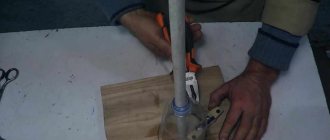Plastic tape made from plastic bottles is used in household farming. Thanks to it, you can strengthen a wooden fence or tie up berry bushes. This rope can withstand up to 50 kg. It depends on its thickness and length. It is mainly used as a fixative.
There are two ways to cut plastic bottles: manual and machine. You can make transparent tape yourself at home. To do this you will need sharp scissors and proper markings.
You must admit that producing such material manually is a rather labor-intensive process. A special device will help make cutting transparent tape easier.
What can a bottle cutting device be made from? What materials will be needed to build such a structure? The answers to these questions are presented in our article. Advice from experienced craftsmen will help you cope with the task.
Advantages of plastic tape
There are several positive qualities of transparent tape in the household. These include:
- does not deteriorate when exposed to sunlight;
- long service life;
- resists low temperatures;
- can withstand up to 80 kg;
- low cost of material;
- no odor;
- decorativeness.
DIY bottle cutter
It has long been known that plastic can lie in the ground for many years without decomposing, thereby causing severe harm to the environment.
To recycle such waste, which can be put to useful use in the future, enterprising people came up with a bottle cutter.
It cuts plastic bottles into narrow strips, which are used as a strong fastening and shrinking material. You can learn how to make a bottle cutter with your own hands from the information below.
How to make a bottle cutter with your own hands
Application of polyethylene tape
Tape made from plastic bottles is widely used in everyday life and households:
- In the manufacture of brooms and brushes.
- For use as shrink tape in the garden for tying up plants, during the construction of greenhouses.
- As a fishing line
- For the manufacture of wicker furniture, bags, baskets.
You can make two types of bottle cutters with your own hands: manual or locking. Its basis is a blade, usually from a stationery knife.
It is inexpensive, very sharp, and does not require sharpening.
A portable version of the device for cutting plastic bottles is very useful, because as a result you can get a strong rope, fishing line, tape for wrapping the handles of any tools, weaving nets and other items necessary for survival. The advantage of such a tape is that when heated, it shrinks several times, tightening and securely securing what is wrapped in it.
DIY plastic bottle cutter
Simple bottle cutter
The simplest option, a camping bottle cutter, can be made with your own hands as follows:
- You will need a wooden block measuring 2.5x2.5x12-15 cm. At one end, cuts are made with a depth corresponding to the thickness of the tape being cut. You can make several of them so that each one cuts the tape to a different width.
- The blade from a stationery knife is attached to the top of the block above the cuts. This can be done using hot-melt glue, so that when traveling you can remove the knife by heating the adhesive layer to replace the blade or sharpen it.
- The bottom of the bottle is cut off, a small incision is made, and it is pulled through a cut of the required width. Now you need to pull the cut end, cutting the bottle to the very neck.
The video clearly shows the manufacturing process of this simple device.
How to make equipment for cutting plastic tape?
The device for cutting plastic bottles consists of simple parts and elements. For this you will need:
- wooden base. Its width must be at least 30 cm;
- medium size washers 10 pcs.;
- small diameter washer 4 pcs.;
- drill 2 pcs. Its diameter must correspond to the size of the washer;
- a small part of a stationery knife 10 cm;
- screwdriver and wrench;
- simple pencil.
Thanks to this machine, cutting plastic bottles with your own hands is fast and efficient, and the thread has a uniform texture. The process of creating equipment includes several stages:
Markings are made on a wooden base to fix washers of different diameters. For this you will need a simple pencil. Using a screwdriver, make through holes at the marks.
Next, insert a bolt to secure the washers. The lower part is secured with a nut. To prevent the joint from coming loose when using the machine, it is recommended to tighten it with a wrench.
The width of the plastic tape can be adjusted by moving the washers to the desired distance. Basically, this gap is 1 cm. A through hole is made on a stationery knife. It is placed on top of metal parts.
An additional nut will help connect the knife to the machine structure. In this case, you should not tighten it too much. This will create discomfort during the work process.
When the equipment is ready, it is checked for functionality. To do this, the bottom of the bottle is cut off and secured between the nuts. Now one edge is cut with a sharp knife blade, and the other is turned clockwise. The result is a plastic tape of the desired size. The photo of cutting plastic bottles shows the work process.
Types of glass cutters for bottles
Today there are many ready-made devices for cutting glass jars and bottles. They all have a different design, but according to the type of action they are divided into only two groups: cutting and heating. The general principle of both groups remains the same - the bottle is fixed in a horizontal position and rotates around a glass cutter or heating element. The operating principle of the devices is quite similar, but has some peculiarities. The roller glass cutter for bottles has a simple design and is widely used by DIY enthusiasts. Can be assembled with your own hands from available materials. The cost of the finished device varies from several hundred to a couple of thousand rubles. The cut line is fairly straight, but the edges require sanding. The best option for home craftsmen. A bottle cutter with a heating element has a more complex mechanism, but also a higher quality cut. The device operates from the mains or battery. You can assemble one if you have special knowledge, but at your own peril and risk. Ready-made devices cost several thousand rubles and are unlikely to interest the majority of the population. Suitable for creative workshops or designers.
Metal cutting machine for plastic bottles
We bring to your attention another idea on how to make a device for cutting bottles. For this you will need:
- a small piece of construction corner;
- stationery blade 10 cm long;
- small nuts 2 pcs.;
- metal drill;
- electric drill;
- hacksaw.
Manufacturing process:
A small through hole is made on the surface of the metal corner. Do the same with a stationery blade.
Having measured the width of the fixing nut with a hacksaw, make notches on the surface of the angle. In the future, they will help adjust the width of the plastic strip. The distance between each mark will be 1.5 cm.
The knife is fixed in the corner part of the metal base using an additional nut.
Note!
FIFA 22 (PS4)Why do you need interior dolls?
- How to choose shoes that don't go out of fashion?
Next, the entire structure must be secured to a solid surface. The production of tape from bottles is carried out by rotating the plastic product clockwise. You should not make sudden movements. This may cause damage to the plastic thread.
What is a bottle cutter?
Based on the name, it’s easy to guess why this device is needed. To make a bottle cutter yourself, you need to have a clear idea of what elements it will consist of. The basic part of any such design is a sharp blade, which, as a rule, is removed from a stationery knife. Its cutting edge is quite sharp and does not require sharpening. The space left on one side of the cutting surface will determine the width of the strips to be cut.
The device comes in manual and locking types. If you suddenly need to cut a plastic container, a bottle cutter will come in handy. Before cutting the container, it is first removed from the bottom. From the small cut made, they begin to cut the plastic rope. As a result, depending on the width of the desired material, you can get either a small ribbon or a thread of impressive length. There is practically no waste left, except perhaps the neck and bottom.
Where can such reliable plastic strips come in handy? There are many areas of their application, in particular:
- For weaving fishing donuts.
- For wrapping tool handles.
- For decorative purposes.











